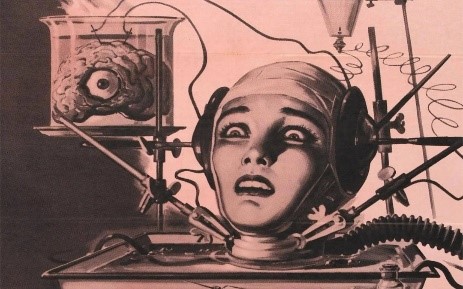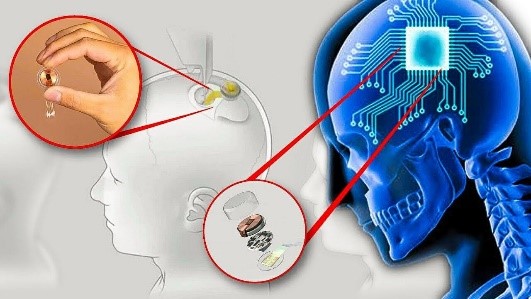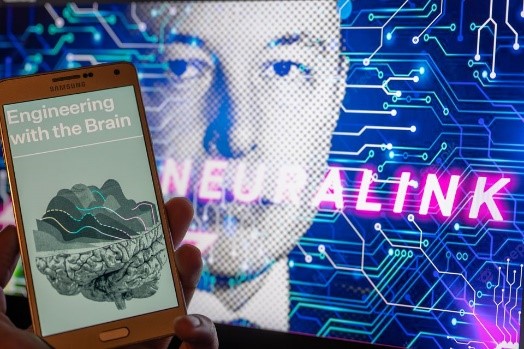Neuralink and Elon Musk’s quest to own the future
Elon Musk’s new brain implant, Neuralink, has been sold as a way of helping people with various ailments and disabilities. But is it?

Recent Elon Musk news: a judge has stopped him paying himself an annual salary of $55 billion and he has implanted a computer on the surface of somebody’s brain.
Pretty routine stuff in Muskland but you should always read between the lines. The implant – known as Neuralink – has been sold as a way of helping people with paralysis, depression, blindness and so on. But, being Elon, he can’t quite stick to the non-threatening script.
Ultimately, he has said, Neuralink would be a “general population device” that would eventually access and store our thoughts, “a back-up device for your non-physical being, your digital soul.” In fairness, he is saying his implant would be a way of giving humans the ability to match the inroads of AI “which I think is an existential problem.”
But, first, Neuralink is intended to go to market with a product called Telepathy.
Telepathy “enables control of your phone or computer, and through them almost any device, just by thinking. Initial users will be those who have lost the use of their limbs. Imagine if Stephen Hawking could communicate faster than a speed typist or auctioneer. That is the goal.”
Meanwhile, of course, he is building rockets in order to establish a human colony on Mars. He hopes to die there, though “not on impact”. Musk simply can’t leave our species alone; he doesn’t want to just sell us stuff, he wants to improve us. It is alleged he is not quite so nice to other species. Animal rights groups have claimed that 1,500 animals – including 280 sheep, pigs and monkeys – have died in horrible suffering in the labs of Neuralink. The future is on the far side of a lake of animal blood.
This, startlingly, made a big splash in the Daily Mail, in an article titled Inside Elon Musk’s Neuralink lab where 1,500 animals have been killed and test monkeys were subjected to “extreme suffering”. Apparently, something called Bioglue was used to fill holes left in the monkey’s heads.
Also we need to point out that Neuralink is not, strictly speaking, new. We have been able to tinker with human brains for some time. Most famously in the US, Austin Beggin was paralysed from the shoulders down after a car accident. Now two devices on his head detect electrical movements in his brain when he imagines moving his arms. Cuffs on his arm pick up the signal and the imaginary movement becomes real.
At Stanford University scientists placed sensors in the brain of a man paralysed from the neck down. These could pick up signals when he thought of writing words and translate them into text on a computer. More familiar are the cochlear implants which improve hearing by electrically stimulating the auditory nerve.
Many scientists without billions of dollars to spend have made such cautious advances. There is, in short, little doubt that something like Musk’s Neuralink may be possible. Equally, many scientists say he is moving too fast and, indeed, Neuralink employees have anonymously agreed.
Laura Cabrera, a neuroethicist, has been surprised by the speed with which the Food and Drug Administration allowed Musk to go ahead with a human trial. She also raised a point about Musk’s judgment: “Is he going to see a brain implant device as something that requires not just extra regulation, but also ethical consideration? Or will he just treat this like another gadget?”
One obvious risk with Neuralink arises from the way it works. A small disk is planted on the brain surface.
“It is,” Musk says, “a Fitbit in your skull, with all the sensors you’d expect to see in a smartwatch.”
From this disk tiny wires extend into the brain. What if these wires migrate randomly?

The problem is that we don’t know as much about the brain as Musk seems to think we do. We know a lot about the structure but little about how it works in the kind of intricate detail to build what Musk calls his “everything device”, something that enhances every aspect of our brains.
“I think it dismisses the level of complexity of the whole process,” says John Donoghue, a neuroscientist at Brown University, “Tackling each condition is a big effort, right? And it could take a long time. And so, I think we have to be very careful to respect the dignity of the people we’re trying to help.”
Muskies may respond that the level of complexity of building electric cars from scratch and better rockets than NASA’s was similarly high. But their hero did it. Not that he is infallible, as Twitter users know. The delivery of his X replacement for the virtual communication network has been poorly executed.
There are yet further dubious implications of the Neuralink. If it works as intended then it will be connected to your phone, your watch and your computer; they, in turn, would be connected to the Cloud. What you then have to face is the possibility that every passing thought or impulse you have may become globally available. Advertisers, hackers, governments, criminals of all sorts would descend on this hitherto private realm to exploit you, judge you, steal from you or, kill you or chuck you in prison forever.
This points to the much bigger issue of the extent to which we will permit technology to change our lives at the most fundamental level. Over the last 300 years our species has become used to world-changing technologies and, over the last thirty years we have enthusiastically welcomed consciousness-changing tech in the form of computers, mobile phones and so on. The next step is not to change consciousness from the outside, but to transform it from the inside.
Musk has recognised that in his claim that Neuralink will permit the human brains to become competent to survive against the inroads of AI. He is saying we can protect our species identity from the assault of the robot species that are likely to emerge in the near future by embracing brain enhancement now.
This process would, of course, grind to a halt if Musk’s race to get inside our heads resulted in some grotesque failure. Marcus Gerhardt, CEO of Blackrock Neurotech, is alarmed at the prospect.
“The communications coming out of Neuralink too often sounds like cowboy activity, right?” He added that some neurosurgeons “are petrified every day that something terrible could occur there and affect the rest of the space.”
But it is hard to imagine Musk ever grinding to a halt. He is, in his own consciousness, the future that should occur.
“What I pursue to do,” he has said, “is to maximise the probability of the future being better.”
Well, maybe. But it is certainly true that, if you disagree with that, you are going to have a hard time stopping his quite staggering mix of determination, hubris and self-belief. It took a judge to halt his pay demands, it will take much more than that to thwart his demands of our species.
Back to the chip surgery, this was not a surprise, as the US Food and Drug Administration (FDA) had given the company clearance in September 2023 to carry out the first trial of its implant on humans.
“Initial results show promising neuron spike detection,” Musk said in a post on X, a day after the chip was implanted.
The first human received an implant from @Neuralink yesterday and is recovering well.
Initial results show promising neuron spike detection.
— Elon Musk (@elonmusk) January 29, 2024
Spikes are activity by neurons, which the National Institute of Health describes as cells that use electrical and chemical signals to send information around the brain and to the body. Musk did not provide further details.
Musk has a long history of bold promises but a spottier record of fulfilling them. In 2016, he wrongly predicted that within two years it would be possible for a Tesla to drive autonomously from New York to Los Angeles. That year he said his SpaceX rocket company would fly to Mars in 2018 – it still has not.
In 2017, Musk suggested Neuralink’s first product would be on the market “in about four years”. However, the recent news was a “significant milestone” towards that goal, said Anne Vanhoestenberghe, a professor of active implantable medical devices at King’s College London.
“For the brain-computer interface community, we need to place this news in the context that while there are many companies working on exciting products, there are only a few other companies who have implanted their devices in humans, so Neuralink has joined a rather small group,” she added.
The startup’s study, Prime, is a trial for its wireless brain-computer interface to evaluate the safety of the implant and surgical robot. Researchers will assess the functionality of the interface, which enables people with quadriplegia to control devices with their thoughts, according to the company’s website. Neuralink and Musk did not immediately respond to a request for further details.

Musk replied to a crypto influencer on X who quoted him as saying the company would “help in restoration of eyesight” to add that Blindsight was another product Neuralink was working on.
Reuters reported that Neuralink was fined for violating US Department of Transportation (DoT) rules regarding the movement of hazardous materials.
During inspections of the company’s facilities in Texas and California in February 2023, DoT investigators found the company had failed to register itself as a transporter of hazardous material, the agency’s records show.
They also found improper packaging of hazardous waste, including Xylene, a flammable liquid that can cause headaches, dizziness, confusion, loss of muscle coordination and death, according to the US Centers for Disease Control and Prevention.
What scientists think of first human trial
Neurotechnology researchers are cautious about Neuralink’s human trial. “What I hope to see is that they can demonstrate that it is safe. And that it is effective at measuring brain signals — short term, but, most importantly, long term,” says Mariska Vansteensel, a neuroscientist at University Medical Centre Utrecht in the Netherlands and president of the international BCI Society.
But there is frustration about a lack of detailed information. There has been no confirmation that the trial has begun, beyond Musk’s tweet. The main source of public information on the trial is a study brochure inviting people to participate in it. But that lacks details such as in what facility implantations are being done and the exact outcomes that the trial will assess, says Tim Denison, a neuroengineer at the University of Oxford, UK.
The trial is not registered at ClinicalTrials.gov, an online repository curated by the US National Institutes of Health. Many universities require that researchers register a trial and its protocol in a public repository of this type before study participants are enrolled. Additionally, many medical journals make such registration a condition of publication of results, in line with ethical principles designed to protect people who volunteer for clinical trials. Neuralink, which is headquartered in Fremont, California, did not respond to Nature’s request for comment on why it has not registered the trial with the site.
Nature examines how Neuralink’s implants compare to other BCI technologies, how the trial will advance BCIs and researchers’ concerns.
Like Blackrock Neurotech in Salt Lake City, Utah, Neuralink targets the activity of individual neurons — an approach that requires electrodes that penetrate the brain. Other companies are developing electrodes that sit on the brain’s surface — some of which are easily removable — to record averaged signals produced by populations of neurons. Neuroscientists have long argued that data from individual neurons are needed for sophisticated thought-decoding. But recent research indicates that averaged signals can allow decoding of complex cognitive processes, such as inner speech. And New York City-based company Synchron has shown that a low-bandwidth surface BCI can provide basic but reliable smartphone control.
Like the Synchron system, Neuralink’s is fully implanted and wireless. That’s a first for BCIs that record from individual neurons. Previous such systems had to be physically connected to a computer through a port in the skull. This poses an infection risk and limits real-world usage.
The Neuralink chip contains 64 flexible polymer threads, providing 1,024 sites for recording brain activity, according to the company’s study brochure. That is considerably more than Blackrock Neurotech’s BCIs, the only other single-neuron recording system to have been implanted long-term in humans. So the Neuralink device could increase the bandwidth of brain–machine communication — although some users have had several Blackrock devices implanted. Neuralink touts the flexibility of its threads, and says it is developing a robot to insert them into the brain.
Neuralink has released little information about its trial’s goals and did not respond to Nature’s request for an interview. But experts expect safety to be paramount at this stage. That involves observing the immediate impact of the device, says Denison — “no strokes, no bleeds, no vasculature damage, anything like that” — as well as for infections, and long-term follow-up to check that it remains safe to have the device implanted.

Neuralink’s study brochure says that volunteers will be followed for five years. It also indicates that the trial will assess the device’s functionality, with volunteers using it at least twice weekly to control a computer and feedback on the experience.
Vansteensel would like to know whether the quality of the detected neuronal signals degrades over time, which is common in existing devices. “You’re not going to replace electrodes easily after implantation,” she says. “I will want to see long-term results.”
Denison is also keen to learn how a wireless system that can be used in non-laboratory settings performs.
Now that human trials have begun, volunteer safety and well-being is a pressing question. “My assumption would be that the FDA and Neuralink are following the playbook to a certain extent,” says Denison. “But we don’t have the protocol. So we don’t know that.”
yogaesoteric
February 9, 2024
